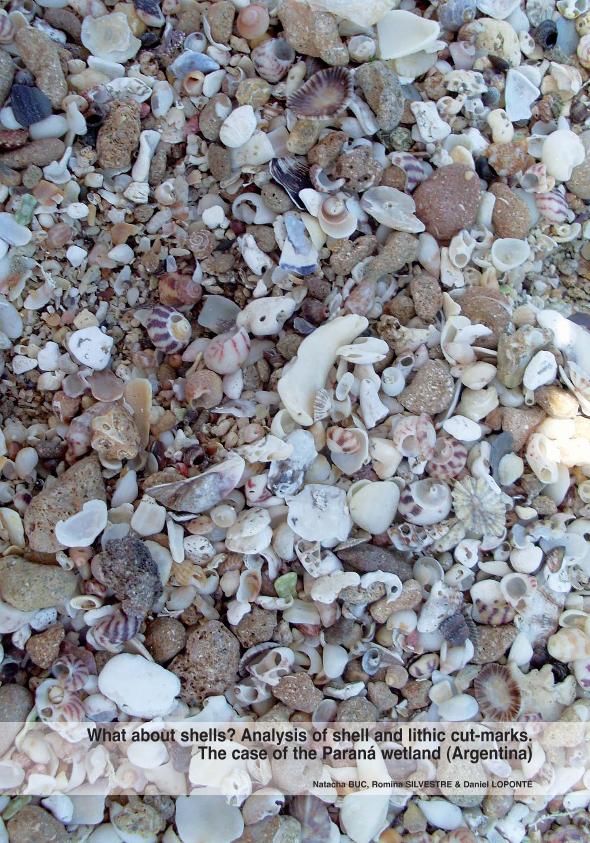Mostrar el registro sencillo del ítem
dc.contributor.author
Buc, Natacha

dc.contributor.author
Sacur Silvestre, Bárbara Romina

dc.contributor.author
Loponte, Daniel Marcelo

dc.date.available
2023-05-08T18:01:50Z
dc.date.issued
2010-11
dc.identifier.citation
Buc, Natacha; Sacur Silvestre, Bárbara Romina; Loponte, Daniel Marcelo; What about shells? Analysis of shell and lithic cut-marks. The case of the Paraná wetland (Argentina); Sociedad de Ciencias Aranzadi; Munibe; 2010; 31; 11-2010; 252-261
dc.identifier.issn
1132-2217
dc.identifier.uri
http://hdl.handle.net/11336/196697
dc.description.abstract
Uno de los rasgos que define a los depósitos arqueológicos localizados en el humedal del Paraná inferior (Región Pampeana, Argentina) durante el Holoceno tardío es la gran abundancia de restos malacológicos. Por otro lado, en términos tecnológicos, los conjuntos se caracterizan por una baja cantidad de artefactos líticos y una gran abundancia de artefactos óseos. En trabajos anteriores planteamos que en el área la tecnología se define por una estrategia de complementariedad entre ambos materiales. Este trabajo tiene como objetivo integrar los restos malacológicos como una fuente alternativa de materia prima, fundamentalmente en el caso de la utilización de filos cortantes. Para ello, desarrollamos un programa experimental donde se evaluaron las posibilidades tecnológicas de las valvas como artefactos para el procesamiento de materiales óseos. En particular, se analizan comparativamente las marcas de corte producidas por filos líticos y de valvas. Los resultados indican que las marcas de corte producidas por ambos materiales son claramente diferenciables. Sin embargo, el reconocimiento de las huellas de valvas en el registro arqueológico es problemático, especialmente si tenemos en cuenta el conjunto de artefactos óseos y los múltiples factores tafonómicos.
dc.description.abstract
One feature that defines the archaeological deposits located in the Low Paraná wetland (Pampean Region, Argentina) during the Late Holocene is the abundance of malacological remains. Moreover, in the technological matter, assemblages are characterized by a low number of lithic tools and a great abundance of bone tools. In previous papers we stated that the technology in this region is defined by a strategy of complementation of both materials. The aim of this work is to include malacological remains as an alternative source of raw material, mainly in the use of cutting edges. For that purpose, we developed an experimental program in order to evaluate the technological possibilities of shells as tools used in bone processing. Particularly, we analyze the cut-marks made by shell and lithic edges. Our results show that it is possible to differentiate cut-marks made by both materials. However, to distinguish shell cut-marks in the archaeological record poses some problems, basically regarding bone tools and multiple taphonomical factors.
dc.description.abstract
Paraná ibaiaren beheko aldeko hezegunean (Panpa eskualdea, Argentina) aurkitutako Holozeno berantiarreko depositu arkeologikoaren ezaugarri bat hondakin malakologikoen ugaritasuna da. Bestalde, termino teknologikoetan, harrizko tramankulu gutxi ageri da multzoetan, eta hezurrezko tramankulu ugari. Aurreko lanetan planteatu genuen, alor honetan, bi materialen arteko osagarritasun-estrategia gisa definitzen dela teknologia. Lan honen helburua da hondakin malakologikoak lehengaien iturri alternatibo gisa integratzea; batik bat, aho zorrotzen erabilerari dagokionez. Horretarako, programa esperimental bat garatu genuen, kuskuek hezurrak prozesatzeko zer aukera teknologiko dituzten ebaluatzeko. Zehazki, hezurrezko ahoek eta kuskuzkoek egindako ebakidura-markak aztertu eta alderatu genituen. Emaitzen arabera, material batez egindako ebakidura-markak eta beste materialaz egindakoak argi eta garbi bereizteko modukoak dira. Hala ere, erregistro arkeologikoan kuskuen aztarnak bereiztea ez da erraza; batik bat, hezurrezko tramankuluen multzoa eta faktore taxonomiko anitzak kontuan hartzen baditugu.
dc.format
application/pdf
dc.language.iso
eng
dc.publisher
Sociedad de Ciencias Aranzadi
dc.rights
info:eu-repo/semantics/openAccess
dc.rights.uri
https://creativecommons.org/licenses/by-nc-sa/2.5/ar/
dc.subject
CONCHA
dc.subject
HUELLAS DE CORTE
dc.subject
ARTEFACTOS LÍTICOS Y ÓSEOS
dc.subject
HUMEDAL DEL RÍO PARANÁ INFERIOR
dc.subject.classification
Arqueología

dc.subject.classification
Historia y Arqueología

dc.subject.classification
HUMANIDADES

dc.title
What about shells? Analysis of shell and lithic cut-marks. The case of the Paraná wetland (Argentina)
dc.title
What about shells? Análisis de conchas y de marcas de corte. El caso del humedal del Río Paraná inferior (Argentina)
dc.type
info:eu-repo/semantics/article
dc.type
info:ar-repo/semantics/artículo
dc.type
info:eu-repo/semantics/publishedVersion
dc.date.updated
2023-05-03T13:26:02Z
dc.identifier.eissn
1132-2217
dc.journal.volume
2010
dc.journal.number
31
dc.journal.pagination
252-261
dc.journal.pais
España

dc.journal.ciudad
San Sebastián
dc.description.fil
Fil: Buc, Natacha. Secretaría de Cultura de la Nación. Dirección Nacional de Cultura y Museos. Instituto Nacional de Antropología y Pensamiento Latinoamericano; Argentina. Consejo Nacional de Investigaciones Científicas y Técnicas; Argentina
dc.description.fil
Fil: Sacur Silvestre, Bárbara Romina. Universidad Nacional de Misiones. Facultad de Humanidades y Cs.sociales. Secretaria de Investigación y Posgrado; Argentina. Consejo Nacional de Investigaciones Científicas y Técnicas; Argentina
dc.description.fil
Fil: Loponte, Daniel Marcelo. Secretaría de Cultura de la Nación. Dirección Nacional de Cultura y Museos. Instituto Nacional de Antropología y Pensamiento Latinoamericano; Argentina. Consejo Nacional de Investigaciones Científicas y Técnicas; Argentina
dc.journal.title
Munibe
dc.relation.alternativeid
info:eu-repo/semantics/altIdentifier/url/https://dialnet.unirioja.es/servlet/articulo?codigo=5200723
Archivos asociados
